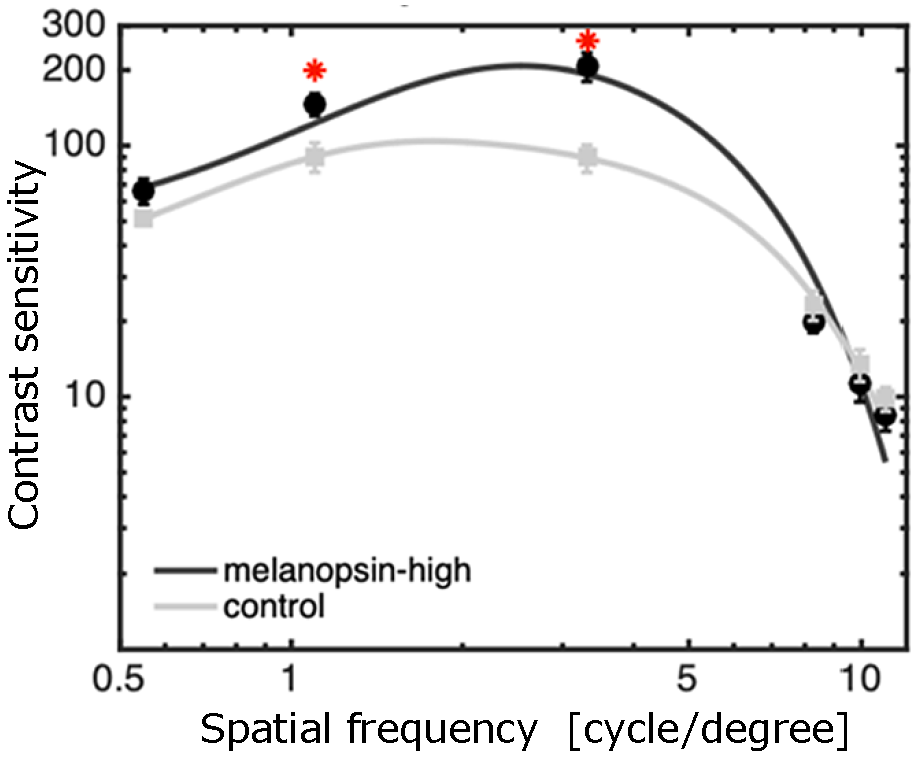Light quality enhances contrast vision
Summary Text
Contrast vision is the ability to distinguish between different levels of luminous shades of text and images.In general, contrast sensitivity is low in dark environment and increases as the light becomes brighter andit has been known that further brightening does not improve sensitivity any further. In this study, weexperimentally demonstrated that contrast sensitivity in humans can be improved by using a speciallighting system that can selectively stimulate melanopsin cells in the retina.
Full Text
Prof Sei-ichi Tsujimura of the Nagoya City University and Prof Su-Ling Yeh of National Taiwan Universityand Kagoshima University, have discovered that our visual acuity (contrast sensitivity) can be improved byusing a light with a special spectrum that can selectively stimulate melanopsin cells in the retina.
Background
The retina of our eye contains cone photoreceptor cells, which identify colors in bright environment, androd photoreceptor cells, which work in the dark. It has long been thought that humans see and identifyobjects by these two types of photoreceptor cells alone. On the other hand, around 2000, the thirdphotoreceptor cells called melanopsin ganglion cells (ipRGCs) were discovered in the retina. Themelanopsin cells have been reported to influence circadian rhythm regulation, pupillary light reflex,brightness perception, mood and so on. For this reason, the study of melanopsin cell function is of greatimportance and has challenged many researchers.
Research findings
Professor Tsujimura's laboratory had developed the experimental device that can stimulate onlymelanopsin cells for the first time in the world by adjusting the colour of light (spectrum), and hasconducted experiments on the contribution of melanopsin cells to contrast sensitivity. Contrast sensitivityis the ability to distinguish between different shades of brightness in text and images and is one of themost important characteristics in our vision. For example, a high contrast sensitivity enables people todistinguish between an object and the background behind it. In general, contrast sensitivity is lower indark environments and increases as the light becomes brighter. On the other hand, further brighteningdoes not improve sensitivity any further. In this research, Professor Tsujimura and his collaboratorsdiscovered that contrast sensitivity in humans is enhanced when the amount of stimulation to melanopsincells is increased without changing the luminance or chromaticity of the illumination light.
In this study, contrast sensitivity was enhanced by using a lighting system with a special spectrum thatselectively stimulates melanopsin cells without changing the brightness or colour of the light. This couldlead to the development of new innovative lighting devices and displays, rather than simply changing thecolour or light intensity. We will continue our research into human vision and propose optimal lightenvironments by clarifying the mechanisms in the brain.
Contrast vision is the ability to distinguish between different levels of luminous shades of text and images.In general, contrast sensitivity is low in dark environment and increases as the light becomes brighter andit has been known that further brightening does not improve sensitivity any further. In this study, weexperimentally demonstrated that contrast sensitivity in humans can be improved by using a speciallighting system that can selectively stimulate melanopsin cells in the retina.
Full Text
Prof Sei-ichi Tsujimura of the Nagoya City University and Prof Su-Ling Yeh of National Taiwan Universityand Kagoshima University, have discovered that our visual acuity (contrast sensitivity) can be improved byusing a light with a special spectrum that can selectively stimulate melanopsin cells in the retina.
Background
The retina of our eye contains cone photoreceptor cells, which identify colors in bright environment, androd photoreceptor cells, which work in the dark. It has long been thought that humans see and identifyobjects by these two types of photoreceptor cells alone. On the other hand, around 2000, the thirdphotoreceptor cells called melanopsin ganglion cells (ipRGCs) were discovered in the retina. Themelanopsin cells have been reported to influence circadian rhythm regulation, pupillary light reflex,brightness perception, mood and so on. For this reason, the study of melanopsin cell function is of greatimportance and has challenged many researchers.
Research findings
Professor Tsujimura's laboratory had developed the experimental device that can stimulate onlymelanopsin cells for the first time in the world by adjusting the colour of light (spectrum), and hasconducted experiments on the contribution of melanopsin cells to contrast sensitivity. Contrast sensitivityis the ability to distinguish between different shades of brightness in text and images and is one of themost important characteristics in our vision. For example, a high contrast sensitivity enables people todistinguish between an object and the background behind it. In general, contrast sensitivity is lower indark environments and increases as the light becomes brighter. On the other hand, further brighteningdoes not improve sensitivity any further. In this research, Professor Tsujimura and his collaboratorsdiscovered that contrast sensitivity in humans is enhanced when the amount of stimulation to melanopsincells is increased without changing the luminance or chromaticity of the illumination light.
In this study, contrast sensitivity was enhanced by using a lighting system with a special spectrum thatselectively stimulates melanopsin cells without changing the brightness or colour of the light. This couldlead to the development of new innovative lighting devices and displays, rather than simply changing thecolour or light intensity. We will continue our research into human vision and propose optimal lightenvironments by clarifying the mechanisms in the brain.

Figure 1: Differences in vision according to contrast sensitivity (observer's view).
Left: low contrast sensitivity vision, right: high contrast sensitivity vision.

Fig. 2 Spatial frequency characteristics of contrast sensitivity.
Melanopsin-high: melanopsin cell stimulation condition; Control: control condition.


